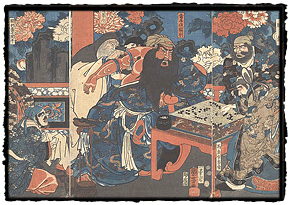Introduction
Page 2 of 2
 Although kabuki actors and geisha appear in some of the UCSF prints, the portrayal
of medical subjects fits most comfortably in the genre of themes from history and legend,
perfected by the great mid-nineteenth-century print designer, Utagawa Kuniyoshi (1797-1861). Kuniyoshi designed eight of the UCSF prints, among them a classic triptych in
which the Chinese Han dynasty general Guan Yu (160-219) is shown being treated for an
arrow wound. Although kabuki actors and geisha appear in some of the UCSF prints, the portrayal
of medical subjects fits most comfortably in the genre of themes from history and legend,
perfected by the great mid-nineteenth-century print designer, Utagawa Kuniyoshi (1797-1861). Kuniyoshi designed eight of the UCSF prints, among them a classic triptych in
which the Chinese Han dynasty general Guan Yu (160-219) is shown being treated for an
arrow wound.
Although the medical-theme prints typically deal with current, not past events, they
often feature famous warriors, invoked to help stave off illness, or they render preventive
measures in anthropomorphic terms -- as in images of bucket-, bean-, or wheat-headed
figures attacking a demon (the disease) — both elements linking them to Kuniyoshi's
artistic practices.
Kuniyoshi's students feature prominently among the artists represented in the
UCSF collection. Yoshitora (fl. 1850-80), Yoshifuji (1828-87), Yoshimori (1830-84), and
Yoshitoshi (1839-92), were all pupils of Kuniyoshi; other artists, such as Sadahide (1807-73), who specialized in pictures of foreigners, employ a related manner.
Although it is difficult to generalize about such a wide range of prints, their
depiction of medical subjects conforms in most cases to stylistic conventions well
established in earlier ukiyo-e. For example, small or large groups of figures are isolated
in these prints against a background that typically is blank or enlivened by the simplest
indication of setting: a few waves or a distant mountain peak. The figures, which
inhabit a narrow foreground space, are defined by simple ink outlines filled with flat
areas of color or textile patterns; only rarely is shading employed, and then it is usually
confined to depictions of foreigners or supernatural beings.
While expressive of some emotion, the faces are also rather generic: a few short
strokes indicate the eyes, brows, nose, and mouth, leaving little room for the
representation of age or individual features. Rather than Western-style realism, these
pictures rely on the language of familiar human — and demonic -- types to inform,
persuade, and entertain.
Ukiyo-e prints were products of a remarkable collaboration between print
publishers, designers, master block carvers, and printers. The publisher was the
impresario who brought together the other, highly specialized team members. Having
obtained a detailed sketch from the artist, he supervised the carving of multiple cherrywood blocks: a finely detailed key block, rendering the outlines of the design, and as
many as a dozen separate blocks for printing each of the colors. The printer then stepped
in, applying color to the blocks and printing them in succession, carefully registering the
edges, and rubbing the paper (placed facedown on the block) to evenly transfer the
colors to the page.
Despite all this labor, the finished prints were relatively inexpensive items, cheaply
sold from the publisher's shop or distributed by itinerant vendors to ordinary
townspeople: merchants, artisans, and other tradesmen. Although published in multiples of a
hundred copies for the more popular editions, the prints were ephemeral, tossed away once fashions, celebrities — or illnesses — changed.
The surviving prints represent only a fraction of much larger original editions.
Indeed, many of the prints may have originally been given away gratis, as advertisements
for patent medicines and cosmetic products, making their preservation here even more
impressive.
|
|
|

